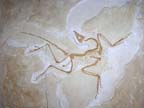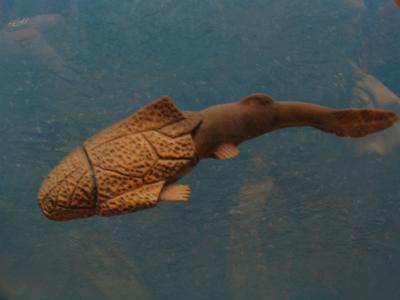 |
 |
 |
 |
 |
Produced
by the Population Genetics and Evolution class, Furman University |
||||
 |
 |
 |
 |
 |
Produced
by the Population Genetics and Evolution class, Furman University |
||||
 |
The
Silurian: Placoderms |
 |
||
| Placoderms
were “armored” fish that evolved during the early Silurian
and flourished during the Devonian. They were one of the first groups
of jawed fishes, and so represent the first vertebrates that could feed
on large prey. They would radiate into some of the most fearsome predators
of the Devonian Period. They were characterized by a cartilaginous skeleton,
a long lower dorsal fin that included the tip of the vertebral column
(heterocercal tail), and pectoral fins (Viney 2008). Also, they were the
first vertebrates to evolve paired pelvic fins. Their “armor”
consisted of dermal bony plates that were articulated by either distinctive
joints or were fused as a single unit. They lacked true teeth and were
instead equipped with shearing and/or crushing structures on their jaws
(Murphy 2005). Most of the fossils that have been recovered and studied
are classified on the thoracic and head shields, while a few were found
to contain the heterocercal tail and paired pelvic fins (Viney 2008).
Placoderms had a neck joint between the necrocranium and synarcual that
allowed them to lift the anterior portion of their head shield (Viney
2008, Gardiner 1984). This mobility is important for their role as predators. Page by Iggy Gaska |
 |
| Placoderm fish. Picture From: armadaproject.org | |
|
Gardiner GB.1984. The Relationship of Placoderms. Journal of Vertebrae Paleontology. Pg 379-380. Murphy CD.2005. More about Placoderms. Devonian Times. pg1. Viney M.2008. Armored Jawed Fish: Placoderms. The Virtual Petrified Wood Museum. pg 1.
|